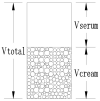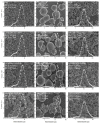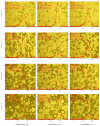Preparation and Physico-Chemical Characterization of OSA-Modified Starches from Different Botanical Origins and Study on the Properties of Pickering Emulsions Stabilized by These Starches
- PMID: 36772007
- PMCID: PMC9918976
- DOI: 10.3390/polym15030706
Preparation and Physico-Chemical Characterization of OSA-Modified Starches from Different Botanical Origins and Study on the Properties of Pickering Emulsions Stabilized by These Starches
Abstract
Native starch (NS) from different botanical origins (native rice/tapioca/oat starch, NRS/NTS/NOS) were hydrophobically modified by octenyl succinic anhydride (OSA), and the octenyl succinic (OS) groups were successfully introduced in the starch molecules which obtained OS-starch (OSRS, OSTS and OSOS) with different levels of modification (0.5%, 1.0%, 1.5%, 2.0%, 2.5%, 3.0%) and degree of substitution (DS). The structural properties of the OS-starch, such as granule size, crystal, wettability and morphology were studied, and the OS-starch was used as particulate stabilizers to produce oil-in-water (O/W) Pickering emulsions. The emulsion index, droplet size distribution and microstructures of Pickering emulsions produced by different OS-starches were compared. OSA modification had almost no effect on the morphology or crystal structure types of three kinds of NS and OS-starch but markedly increased the contact angle and particle size distribution of OSRS, OSTS and OSOS. Esterification reaction of OSA and starch mainly occurred in amorphous regions of starch, and the OSA significantly improved the emulsifying capacity of OSRS, OSTS and OSOS granules and thus stabilized emulsions formed at higher levels (2.5% and 3.0%) of modification of OS-Starch exhibited better stability; the ability of OS-starch to stabilize Pickering emulsion was 3.0% OSRS > 3.0% OSOS > 3.0% OSTS, respectively. Observation and structural properties analysis of OS-starch granules and Pickering emulsion droplets showed that the number and thickness of the starch granules on the oil-water interface of the emulsion droplets increased with improvement of the OSA modification level, and an aggregation state was formed between the OS-starch granules, which was also enhanced with the OSA modification levels. These were all necessary for the Pickering emulsion stabilized by starch granules to remain in a steady state.
Keywords: OSA; Pickering emulsions; oat starch; rice starch; stability; tapioca starch.
Conflict of interest statement
The authors declare no conflict of interest.
Figures









Similar articles
-
Preparation and properties of OSA-modified taro starches and their application for stabilizing Pickering emulsions.Int J Biol Macromol. 2019 Sep 15;137:277-285. doi: 10.1016/j.ijbiomac.2019.06.230. Epub 2019 Jun 29. Int J Biol Macromol. 2019. PMID: 31260771
-
Comparative study of rheological properties and Pickering emulsion stabilizing capacity of nonenyl succinic anhydride and octenyl succinic anhydride modified amaranth starches.Int J Biol Macromol. 2023 Dec 31;253(Pt 2):126606. doi: 10.1016/j.ijbiomac.2023.126606. Epub 2023 Aug 29. Int J Biol Macromol. 2023. PMID: 37652318
-
Modification of Oxalis tuberosa starch with OSA, characterization and application in food-grade Pickering emulsions.J Food Sci Technol. 2021 Aug;58(8):2896-2905. doi: 10.1007/s13197-020-04790-y. Epub 2020 Oct 12. J Food Sci Technol. 2021. PMID: 34294951 Free PMC article.
-
A review on octenyl succinic anhydride modified starch-based Pickering-emulsion: Instabilities and ingredients interactions.J Texture Stud. 2022 Sep;53(5):581-600. doi: 10.1111/jtxs.12663. Epub 2022 Apr 13. J Texture Stud. 2022. PMID: 35119704 Review.
-
Starch-based particles as stabilizers for Pickering emulsions: modification, characteristics, stabilization, and applications.Crit Rev Food Sci Nutr. 2025;65(10):1841-1856. doi: 10.1080/10408398.2024.2312285. Epub 2024 Mar 4. Crit Rev Food Sci Nutr. 2025. PMID: 38436130 Review.
Cited by
-
The Preparation of Curcumin-Loaded Pickering Emulsion Using Gelatin-Chitosan Colloidal Particles as Emulsifier for Possible Application as a Bio-Inspired Cosmetic Formulation.Pharmaceutics. 2024 Mar 3;16(3):356. doi: 10.3390/pharmaceutics16030356. Pharmaceutics. 2024. PMID: 38543250 Free PMC article.
-
Improved Viability of Probiotics via Microencapsulation in Whey-Protein-Isolate-Octenyl-Succinic-Anhydride-Starch-Complex Coacervates.Molecules. 2023 Jul 28;28(15):5732. doi: 10.3390/molecules28155732. Molecules. 2023. PMID: 37570702 Free PMC article.
References
-
- Aveyard R., Binks B.P., Clint J.H. Emulsions stabilised solely by colloidal particles. Adv. Colloid Interface Sci. 2003;100:503–546. doi: 10.1016/S0001-8686(02)00069-6. - DOI
-
- Yusoff A., Murray B.S. Modified starch granules as particle-stabilizers of oil-in-water emulsions. Food Hydrocoll. 2011;25:42–55. doi: 10.1016/j.foodhyd.2010.05.004. - DOI
-
- Kargar M., Fayazmanesh K., Alavi M., Spyropoulos F., Norton I.T. Investigation into the potential ability of Pickering emulsions (food–grade particles) to enhance the oxidative stability of oil–in–water emulsions. J. Colloid Interface Sci. 2012;366:209–215. doi: 10.1016/j.jcis.2011.09.073. - DOI - PubMed
LinkOut - more resources
Full Text Sources
Miscellaneous

